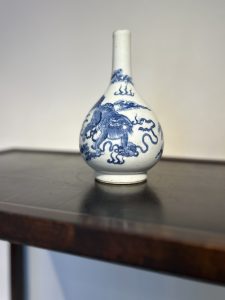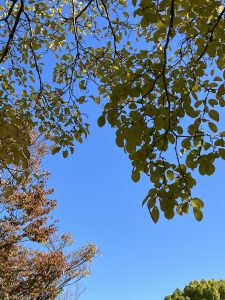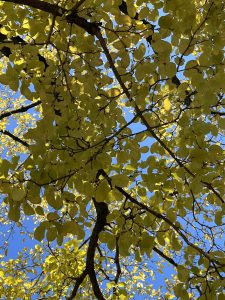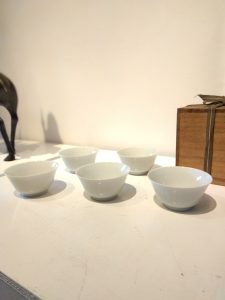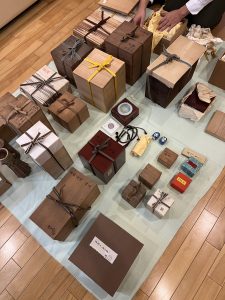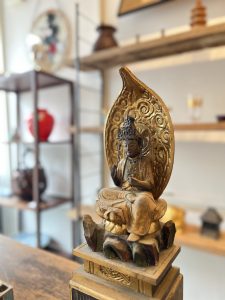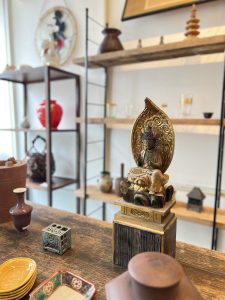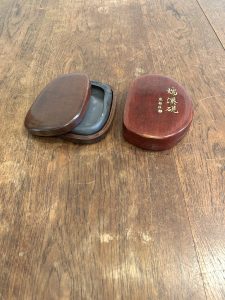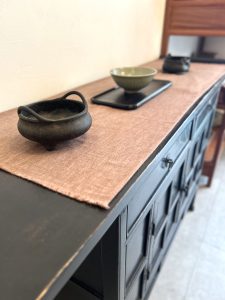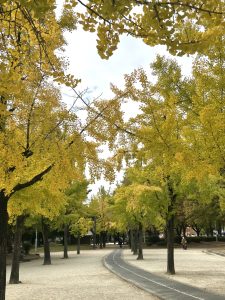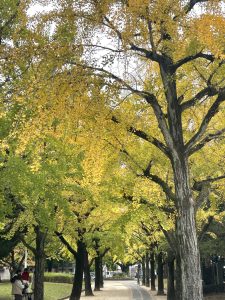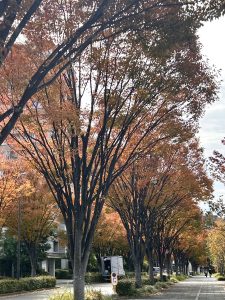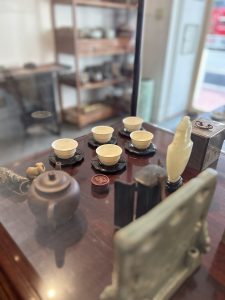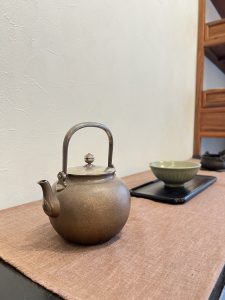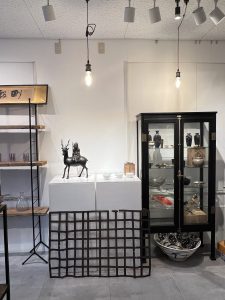「相続と骨董品買取のお話 その9」食器の価値(愛知県名古屋市千種区姫池通 骨董買取 古美術風光舎)
2025.11.16
今回の「相続と骨董品買取のお話」は、買取のご相談が多い御品のひとつ「食器類」についてのお話です。
遺品整理や生前整理など実家やご自宅のお片付けの際に、押し入れの奥から見つかるたくさんの食器たち。古いか古くないか、またどの程度売れる食器であるか、全くお値段がつかない食器であるかの線引きに、お困りの方が多いように感じます。ご家族が大切に保管されていた骨董品の食器ですので、その価値を知りたい、または買取可能なのかは当然気になりますよね。
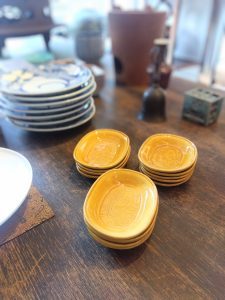
もちろん古い骨董品の食器は、売る事が出来ます。しかし、売れると一口に言っても、査定額に幅があります。
骨董品として扱われる基準となる100年程度の古さがあれば、十分な査定額がつきますが、100年経っているかどうか分からない、いつから置いているか分からない、そういった物の時代を判断するために骨董業者がいます。
また、そこまで古くなくても売れる食器は多数ございますので、まずは一度、骨董業者に見せる事が大切ですね。
おおまかに洋食器と和食器に分けられる食器ですが、もう少し詳しくご紹介します。
1.洋食器
洋食器においては、マイセンやコペンハーゲンなどの有名メーカーは古くから存在し、裏の印で年代や現在の価値が判断できる場合が多いです。
また、日本の洋食器メーカーには、大倉陶園・ノリタケ・ナルミなどがあります。
戦前のものは「オールド大倉」や「オールドノリタケ」と呼ばれ、コレクターの間で人気が高く、高価値がつくことも少なくありません。
2.ガラス食器
ガラス製品では、江戸切子、型吹きガラス、プレスガラスなど、江戸時代から明治~昭和にかけての骨董価値のあるガラス製品が数多く存在します。
特に、薩摩切子は江戸切子のなかでも有名で、現存数が少なく、少々の傷があっても買取可能なものの一つです。
また、型吹きガラスやプレスガラスには、ぐい呑や銘々皿、果物皿、鉢など、様々な食器があります。
3.和食器
和食器の代表的なものには、伊万里焼や瀬戸焼などの磁器があります。
また、漆のお椀やお皿などは、技法や産地の違いによって、骨董価値のあるものが多く存在します。
これらの食器は、製造年代や製作者、デザイン、状態などによって価値が大きく変わるため、専門家の鑑定が必要となる場合もあります。
このように骨董品の食器の価値は、製造年代、製作者、デザイン、状態など、様々な要素によって決まります。
高価買取を目指すためには、状態を良好に保ち、セット品や箱などの付属品を揃えておくことが重要です。
シミや傷がある、作家の署名がない、価値がわからないなどの食器も売却買取はもちろん可能でございます。いずれの場合でもその価値を確かめることは大切ですので、ご相談は専門の業者への依頼をお勧めいたします。
また、少々の傷でも売れる物もありますので捨てずに鑑定、査定に出す事をお勧めいたします。
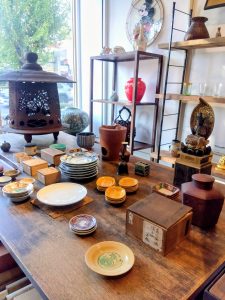
古美術風光舎では食器の鑑定・買取のご相談など無料で行っておりますのでお気軽にご相談くださいませ。
(スタッフT)
This installment of “Inheritance and Antique Appraisal” focuses on tableware, one of the most frequently appraised items.
When sorting through belongings at a family home or your own residence—whether for estate clearance or pre-need organization—plenty of tableware surfaces from the depths of closets. Many seem troubled by the distinction between what’s old and what isn’t, or whether the tableware has any resale value at all. Since these are antique tableware items cherished and preserved by family members, it’s only natural to want to know their value or if they’re eligible for purchase.
Of course, antique tableware can be sold. However, even when we say it can be sold, the appraisal value can vary significantly.
If the items meet the standard for being considered antiques—typically around 100 years old—they can command a good appraisal value. But what if you don’t know if they’re 100 years old? What if you don’t know how long they’ve been stored? That’s where antique dealers come in to determine the era of such items.
Furthermore, many pieces can be sold even if they aren’t that old, so it’s important to first have an antique dealer take a look.
While tableware can be broadly divided into Western and Japanese styles, let’s look at them in a bit more detail.
1. Western Tableware
For Western tableware, renowned manufacturers like Meissen and Copenhagen have existed for centuries. Their marks on the reverse often reveal the piece’s age and current value.
Notable Japanese Western tableware makers include Ōkura Tōen, Noritake, and Narumi.
Pre-war pieces, known as “Old Ōkura” or “Old Noritake,” are highly sought after by collectors and frequently command high prices.
2. Glass Tableware
Numerous glass items with antique value exist, spanning from the Edo period through the Meiji and Showa eras. These include Edo Kiriko cut glass, mold-blown glass, and pressed glass.
Satsuma Kiriko, particularly renowned among Edo Kiriko pieces, is scarce today. Even items with minor flaws are often purchasable.
Mold-blown and pressed glass encompass various tableware items such as sake cups, individual plates, fruit bowls, and bowls.
3. Japanese Tableware
Representative Japanese tableware includes porcelain such as Imari ware and Seto ware.
Lacquer bowls and plates also hold significant antique value, varying based on technique and place of origin.
The value of these pieces fluctuates greatly depending on their production era, maker, design, and condition, sometimes requiring expert appraisal.
Thus, the value of antique tableware is determined by various factors including production date, maker, design, and condition.
To aim for a high purchase price, it is crucial to maintain good condition and keep accessories like sets and boxes together.
Tableware with stains or scratches, lacking an artist’s signature, or whose value is unknown can certainly be sold or appraised. In any case, confirming its value is important, so we recommend consulting a specialist dealer.
Furthermore, even items with minor damage may still be sellable, so we advise against discarding them and instead having them appraised and evaluated.
At Kofuzou Fuko-sha, we offer free consultations for the appraisal and purchase of tableware. Please feel free to contact us.
(Staff T)
*******************
ご実家の整理やお片付けなどをされている方のご相談などが多くございます。
お片付けなどくれぐれもご無理のないようになさってくださいませ。
風光舎では古美術品や骨董品の他にも絵画や宝石、趣味のお品など様々なジャンルのものを買受しております。
お片付けをされていて、こういうものでもいいのかしらと迷われているものでも、どうぞお気軽にご相談下さいませ。
また風光舎は、出張買取も強化しております。ご近所はもちろん、愛知県内、岐阜県、三重県その他の県へも出張いたします。
まずは、お電話お待ちしております。
愛知県名古屋市千種区姫池通
骨董 買取【古美術 風光舎 名古屋店】
TEL052(734)8444
10:00-18:00 OPEN


